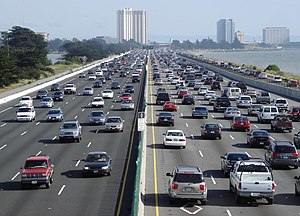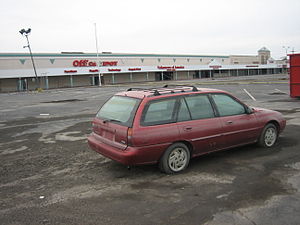I’m sorry that I have been bashing the parking issue to a bloody pulp and I will move on to other things, but if you want to know what is wrong with urban planning today, how unresponsive we’ve become to market conditions, and how poorly we treat our towns and cities, pedestrians and transit systems, please read this post.
I would like to add a bit of anecdotal experience of living in a large city and commuting and the insidious effect that parking minimums have on cities, generally, and transit, specifically.
I live in the Jefferson Park neighborhood of Chicago. It is part of the city’s famed bungalow belt and is located in the extreme northwest side of the city. Though my part of neighborhood was plated in the 1920’s, most development occurred in the 1940’s and ’50s. As such, it was developed with the automobile in mind. Despite the fact that most homes are on postage size 25’x125′ lots (thank you 1920’s plats!), most of the commercial corridors filled in during the 1940’s-’50s and are auto-oriented.
Because my home has a back alley garage (guaranteed parking) and much of the neighborhood has easy free parking thanks to zoning that requires parking minimums, I actually drive a fair amount, much more than I’d like to. Accordingly,
“A guaranteed parking spot makes use of the automobile a more attractive option”
much to the detriment of transit and pedestrian space.
When the car takes precedence in transportation planning, other things get neglected. When retail is built into “centers” and “strip malls” and not corner stores, pedestrians and transit get neglected. And what are shopping centers and strip malls: just urban design that satisfies parking minimums.
Nothing fires up a local Village Board like eminent domain.
One of my duties as a transportation planner for Metra is to participate in transit-oriented development studies in communities that apply for the grants to fund these studies through the RTA. Tonight we presented a TOD plan in front of the Village Board of a wealthy suburb for discussion. We hoped this discussion would lead to a recommendation for the Board to adopt the study. Alas, we were wrong.
It seems that the third rail of local politics was mentioned, not in the plan, but in discussions of possible tools that the Village could use to implement their plan, should it be adopted. It was noted and explored in the steering committee driving the plan that one possible tool was the use of eminent domain. Eminent domain refers to the action of the state in expropriating property or the rights thereof from a private citizen with monetary compensation but without consent of the owner. This property is taken for public use and in some cases, economic development, as granted by right in Kelo v. City of New London (2005). Because of the Kelo decision and general anti-government sentiment there has been a backlash against government taking private property in general and specifically for use in economic development across the country. This is no different in the Chicago region.
The problem with eminent domain in the planning context is that it politicizes the planning process with issues that have little to do with the actual plan. I have never seen a plan that has actually recommended using eminent domain as an implementation tool in a plan because the political, legal and procedural hurdles are usually so great that it is not worth pursuing. The vast, vast majority of plans are not trying to develop 3,1oo jobs and $1.2m in annual revenues like the New London, CT was. Because of this politicization (“take your government hands off my property!”), the Village Board was unable to weigh the merits of what was actually in the plan.
A good plan is a set of guidelines for decision makers to use in implementing a vision for their community. It is a tool. It says, if we build a parking structure, how much would it cost the government? It identifies how a Village could update their zoning code to fit with today’s market realities. It identifies short range and long range opportunities for implementation. A good plan does NOT tell developers what to build. A good plan does NOT advocate eminent domain. A good plan does NOT ignore property owners which are impacted by the plan.

This morning’s Atlantic Cities article on whether big box stores can reduce vehicle miles traveled (VMT) because it “brings shopping closer to where people live” fundamentally misunderstands the problems that big box stores cause in urban communities and why many urbanites do not want them in their communities even though they may patronize these stores. Nothing about these stores’ design is urban. It is not walkable, there are no accommodations for transit or bike/pedestrians. The only way to access these stores comfortably is with a car. This development pattern drives up traffic locally on urban streets that may not have been designed for these traffic volumes. It impacts neigboring land uses through light pollution from its vast parking lots, through water runoff, and through large deliveries at night in the back of the store (sometimes facing residential neighbors).
That’s not to say that big box stores can’t work in urban areas. They can and do. When you reorient them to face the street, making it easier to access via transit, bicycle and pedestrian modes, reduce parking ratios (per square foot) and build big box stores in a more mixed use environment, they can work in a much more urban-friendly way.
Yonah Freemark over at The Transport Politic says it’s Time to Fight. House Republicans want to turn transportation into an all out ideological battle.

Without a balanced federal transportation policy, more of the same traffic congestion is in our future.
This, of course, is bad news for cities and metropolitan areas. As gas prices rise higher due to peak oil, supply and demand and geopolitical issues, it is even more urgent that the U.S. plan for a multi-modal approach to federal transportation policy. The automobile as the dominant form of mobility option is not sustainable or feasible. In the Chicago region, the Regional Transportation Authority estimates that the CTA, Metra and Pace could lose up to $450 million in capital each year. In a region with a system with a $10 billion backlog of capital projects, we simply cannot afford to lose this kind of money.
As Senator Bernie Sanders (I-VT) said once, “Elections have consequences.”
One of the most important lessons in all of this is that elections have consequences. Many people now are beginning to catch on to that. It is no secret that our right-wing Republican colleagues did very well in November 2010. They captured the House of Representatives.
If you care about transportation and urban affairs, please remember this. And most importantly, fight now and call your Representative.





